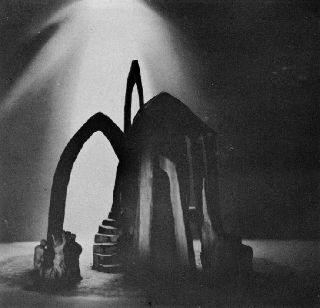The New Stage Craft: Rebelling Against Realism
The Box Set revolutionised the theatre but in the early 1900s European designers Adolphe Appia and Edward Henry Gordon Craig turned the theatre world on its head.
Appia(1862-1928), a Swiss architect and theorist of stage lighting and decor and Craig(1872-1966), an English modernist theatre practitioner, rebelled against the realistic set designs of the time and started creating more abstract environments that were characterised by a breaking up of the two-dimensionality of a space by adding levels and platforms, as well as a more dramatic use of light. Basically they objected to a 3D actor standing on a flat floor surrounded by acres of *realistically painted canvas.




(Ref:Monsalvat)
One of the reasons for the influence of Appia’s work and theories, is that he was working at time when electrical lighting was just evolving. He was one of the first designers to understand the potential of stage lighting to do more than merely illuminate actors and painted scenery.
Another is that he was a man of great vision who was able to conceptualise and philosophise about many of his practices and theories. Appia advocated three elements as fundamental to creating a unified and effective mise en scene.
1. Dynamic and three-dimensional movements by actors
2. Perpendicular scenery
3. Using depth and the horizontal dynamics of the performance space
(Ref: http://www.graphicine.com/adolphe-appia-in-depth/)


(Ref: Mazia Laddour)
Craig was influenced by the work of Appia and like Appia he broke the flat stage floor with platforms, steps, and ramps and replaced the parallel rows of flapping canvas with an elaborate series of tall screens which could suggest the essence of the local. Here is one of his drawings of a stage design illustrating these points. (http://www3.northern.edu/wild/ScDes/sdhist.htm)


(Ref: https://theatrelitwiki.wikispaces.com/Edward+Gordon+Craig) What was happening in the world of theatre was that colour, lighting, and the actors themselves all became of equal importance along with the set design. All working together to create the drama.
Craig is noted for trying to create plays where the movements of the actors began to tell the stories and not the actual settings. He began to attempt to create a type of play where the lighting and the motions of the actors told the plot not just the words. (Ref: https://theatrelitwiki.wikispaces.com/Edward+Gordon+Craig)
And what were our American cousins doing across the ocean? They had
Robert Edmond Jones who had learned of New Stagecraft while studying at Harvard, and went to Europe to study it in action. It is he who is credited with bringing the ideas of New Stagecraft to the mainstream American theatre. He was equally as frustrated with the constraints of realism as Appia and Craig, and he spoke extensively in his lectures about the laziness of American theatre and how unexciting he found realism. In his lectures he once described American realism as usually a record of life at a low pitch and ebb viewed in the sunless light of day. Though he was quick to follow this up by saying that he had no personal problem with realism, he just found it So easy, so lazy, so timid to use for every situation when something more dynamic or visceral could be created. (Ref: https://thea262project.weebly.com/) Please follow this link if you would like to know more on this topic.
We have only stepped a little way onto the stage but enough I hope to give you an idea of what was happening in the world of theatre at the same time as the painters were experimenting with Realism, Impressionism and the various forms of Modernism and Post Modernism.
Tomorrow we are going to learn a little more about Costume.
